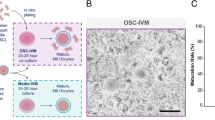Abstract
The mouse embryo assay (MEA) has been used in the field of human in vitro fertilization (IVF) for multiple purposes such as developing embryo culture media, quality control within the laboratory, and procedural training and proficiency testing for embryology staff. In addition, manufacturing companies use the MEA as a means of quality control for the development of embryo culture media and medical devices and to meet the standards of testing for FDA approval of new products. It has long been considered by embryologists and laboratory scientists whether the MEA is an accurate or sensitive test in the quality assessment of culture media and medical devices or if use of this testing is more an obligation. There is no uniformly accepted gold standard method for IVF lab quality control or FDA approval. This review aims to revisit the role of the use of mouse embryos in the formulation of IVF media for clinical use and the different methods of employing the mouse embryo assay for quality control. In addition, we will review the use of the MEA as an important adjunct in the training for embryology staff and fellows in training in reproductive endocrinology and infertility (REI), as well as alternatives to the use of the MEA for these purposes.
Similar content being viewed by others
References
Hammond J. Recovery and culture of tubal mouse ova. Nature. 1949;163(4131):28–9.
Whitten WK. Culture of tubal mouse ova. Nature. 1956;177(4498):96.
McLaren A, Biggers JD. Successful development and birth of mice cultivated in vitro as early embryos. Nature. 1958;182(4639):877–8.
Biggers JD, Gwatkin RB, Brinster RL. Development of mouse embryos in organ cultures of fallopian tubes on a chemically defined medium. Nature. 1962;194(4830):747–9.
Chronopoulou E, Harper JC. IVF culture media: past, present and future. Hum Reprod Update. 2014;21(1):39–55.
Whitten WK, Biggers JD. Complete development in vitro of the pre-implantation stages of the mouse in a simple chemically defined medium. Reproduction. 1968;17(2):399–401.
Whittingham DG. Fertilization of mouse eggs in vitro. Nature. 1968;220(5167):592–3.
Brinster RL. Studies on the development of mouse embryos in vitro. Reproduction. 1965;10(2):227–40.
Gruber I, Klein M. Embryo culture media for human IVF: which possibilities exist? J Turk German Gynecol Assoc. 2011;12(2):110.
Simopoulou M, Asimakopoulos B, Bakas P, Boyadjiev N, Tzanakaki D, Creatsas G. Oocyte and embryo vitrification in the IVF laboratory: a comprehensive review. Folia Med. 2014;56(3):161–9.
Whittingham DG, Leibo SP, Mazur P. Survival of mouse embryos frozen to-196 and-269 C. Science. 1972;178(4059):411–4.
Rall WF, Fahy GM. Ice-free cryopreservation of mouse embryos at – 196 C by vitrification. Nature. 1985;313(6003):573.
Arav A. Cryopreservation of oocytes and embryos. Theriogenology. 2014;81(1):96–102.
Ménézo YJ, Hérubel F. Mouse and bovine models for human IVF. Reprod BioMed Online. 2002;4(2):170–5.
Delaroche L, Oger P, Genauzeau E, Meicler P, Lamazou F, Dupont C, et al. Embryotoxicity testing of IVF disposables: how do manufacturers test? Hum Reprod. 2020;35(2):283–92.
Li M, Drury KC, Williams RS. Suitability of mouse embryos for human IVF QC: zygotes vs. 2-cell embryos. Fertil Steril. 2001;76(3):S230.
Davidson A, Vermesh M, Lobo RA, Paulson RJ. Mouse embryo culture as quality control for human in vitro fertilization: the one-cell versus the two-cell model. Fertil Steril. 1988;49(3):516–21.
Khan Z, Wolff HS, Fredrickson JR, Walker DL, Daftary GS, Morbeck DE. Mouse strain and quality control testing: improved sensitivity of the mouse embryo assay with embryos from outbred mice. Fertil Steril. 2013;99(3):847–54.
Gardner DK, Reed L, Linck D, Sheehan C, Lane M. Quality control in human in vitro fertilization. In Seminars in reproductive medicine 2005 Nov (Vol. 23, No. 04, pp. 319-324). Copyright© 2005 by Thieme Medical Publishers, Inc., New York
Flood LP, Shirley B. Reduction of embryotoxicity by protein in embryo culture media. Mol Reprod Dev. 1991;30(3):226–31.
Ainsworth AJ, Fredrickson JR, Morbeck DE. Improved detection of mineral oil toxicity using an extended mouse embryo assay. J Assist Reprod Genet. 2017;34(3):391–7.
Scott LF, Sundaram SG, Smith S. The relevance and use of mouse embryo bioassays for quality control in an assisted reproductive technology program. Fertil Steril. 1993;60(3):559–68.
Gilbert RS, Nunez B, Sakurai K, Fielder T, Ni HT. Genetic mouse embryo assay: improving performance and quality testing for assisted reproductive technology (ART) with a functional bioassay. Reprod Biol Endocrinol. 2016;14:13.
Wolff HS, Fredrickson JR, Walker DL, Morbeck DE. Advances in quality control: mouse embryo morphokinetics are sensitive markers of in vitro stress. Hum Reprod. 2013;28(7):1776–82.
Hossain A, Aryal S, Osuampke C, Phelps J. Human sperm bioassay for reprotoxicity testing in embryo culture media: some practical considerations in reducing the assay time. Adv Urol. 2010;2010.
Claassens OE, Wehr JB, Harrison KL. Optimizing sensitivity of the human sperm motility assay for embryo toxicity testing. Hum Reprod. 2000;15(7):1586–91.
Hughes PM, Morbeck DE, Hudson SB, Fredrickson JR, Walker DL, Coddington CC. Peroxides in mineral oil used for in vitro fertilization: defining limits of standard quality control assays. J Assist Reprod Genet. 2010;27(2–3):87–92.
Betteridge KJ, Rieger D. Embryo transfer and related techniques in domestic animals, and their implications for human medicine. Hum Reprod. 1993;8(1):147–67.
Acknowledgments
The authors would like to thank Dr. Misty Blanchette-Porter for proofreading of the manuscript.
Author information
Authors and Affiliations
Corresponding author
Additional information
Publisher’s note
Springer Nature remains neutral with regard to jurisdictional claims in published maps and institutional affiliations.
Rights and permissions
About this article
Cite this article
Esfandiari, N., Gubista, A. Mouse embryo assay for human in vitro fertilization quality control: a fresh look. J Assist Reprod Genet 37, 1123–1127 (2020). https://doi.org/10.1007/s10815-020-01768-9
Received:
Accepted:
Published:
Issue Date:
DOI: https://doi.org/10.1007/s10815-020-01768-9




